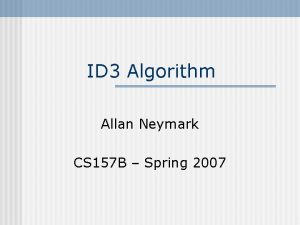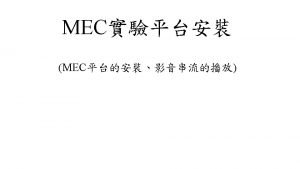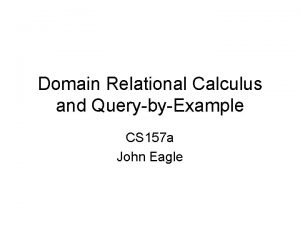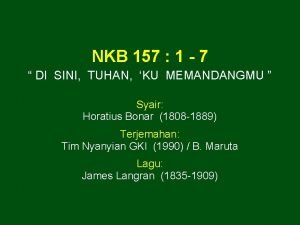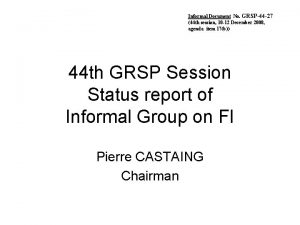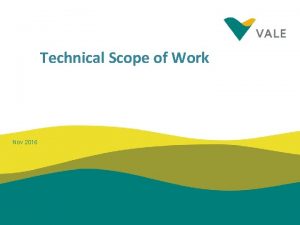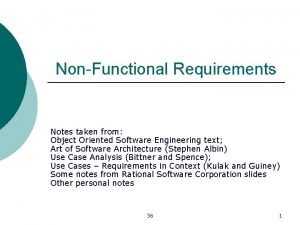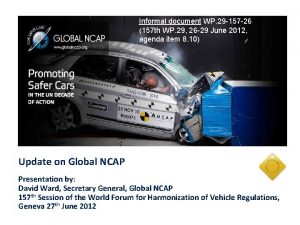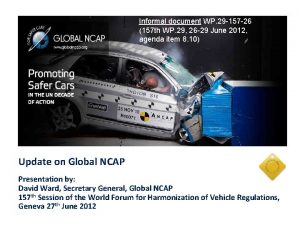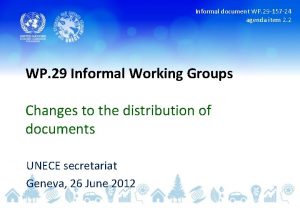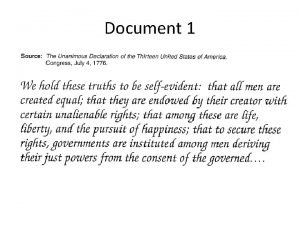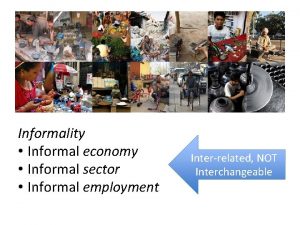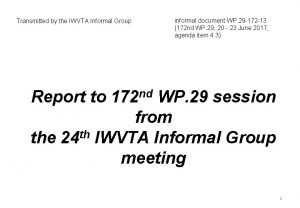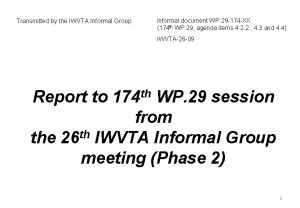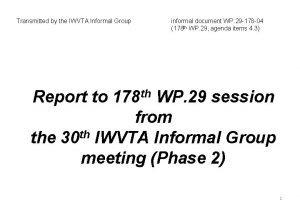Informal document WP 29 157 24 157 th















- Slides: 15

Informal document WP. 29 -157 -24 (157 th WP. 29, 26 -29 June 2012, agenda item 8. 10) World Forum for the Harmonization of Vehicle Regulations (WP. 29) Christopher J. Bonanti United States HOD to WP. 29 Associate Administrator for Rulemaking, NHTSA

Introduction Ø A brief history of the United States New Car Assessment Program (NCAP) Ø The World Forum for the Harmonization of Vehicle Regulations (WP. 29) Ø The relationship between NCAP and the World Forum 2

United States 5 -Star Safety Ratings Program Ø Under the U. S. NCAP program, the National Highway Traffic Safety Administration has been providing information on the safety performance of vehicles for over 30 years Ø The program provides consumers with information about crash protection and rollover safety of vehicles beyond Federal standards Ø The program has helped consumers make informed decisions when purchasing or leasing a new or used vehicle Ø The rating system ranges from 1 to 5 stars, with 1 star being the lowest and 5 stars the highest 3

Measurements of Program Success Ø The success of the program can be measured in how the market has responded Ø Consumers have generated demand for safety features and performance that go beyond Federal requirements Ø Manufacturers now routinely use the star ratings provided by the program in their advertising Ø More and more vehicles have been achieving 4 - and 5 -star ratings at a faster pace 4

Recent Program Enhancements Ø In July 2008, NHTSA published a notice announcing major changes to the program Ø In October 2010, NHTSA implemented the enhanced program beginning with model year 2011 5

Key Changes in the Program Ø The enhanced program: Ø Bases the ratings on protection for a wider range of occupants (use of 50 th percentile male and 5 th percentile female test dummies) Ø Uses improved crash test dummies Ø Adds a new pole test for side crashes Ø Combines all the ratings into an overall vehicle score Ø Identifies those vehicles that have advanced technologies that help prevent crashes in the first place Ø Electronic stability control (ESC) Ø Forward collision warning (FCW) Ø Lane departure warning (LDW) 6

Key Safety Milestones Ø 1978 – NHTSA began testing vehicles for frontal impact protection Ø 1993 – NHTSA began using the 5 -Star Safety Ratings system to assign safety scores based on the level of occupant protection a vehicle provides Ø 1996 – NHTSA began testing and rating vehicles for side impact protection Ø 2000 – NHTSA began testing and rating vehicles for rollover resistance based on a static measurement of a vehicle’s track width and the height of its center of gravity Ø 2003 – NHTSA updated the rollover program to include a dynamic test that measures untripped rollovers Ø 2004 – NHTSA launched a new website, www. Safer. Car. gov, to provide consumers with vehicle safety information 7

Key Safety Milestones Ø 2006 – NHTSA began requiring vehicle manufacturers to include safety ratings information on the vehicle window sticker, also known as the Monroney label Ø 2008 – NHTSA announced the most significant changes in the history of the NCAP program, including the addition of a new side pole test, improved crash test dummies, more stringent ratings criteria, and the identification of vehicles equipped with advanced crash avoidance technologies that meet NHTSA’s performance criteria Ø 2010 – NHTSA implemented the enhanced NCAP program beginning with model year 2011 and provided the safety ratings of tested vehicles and vehicles equipped with advanced crash avoidance technologies on www. Safer. Car. gov 8

Global Harmonization: WP. 29 Ø The World Forum for Harmonization of Vehicle Regulations works to develop harmonized UN - Global Technical Regulations (GTR) and UN - Regulations for vehicle safety, theft prevention and environmental friendliness Ø WP. 29 stakeholders and participants include: Ø Over 50 governments Ø International trade associations of vehicle manufacturers and component suppliers Ø International associations of consumer advocacy groups Ø Standard setting organizations such ISO and SAE 9

Global Harmonization: WP. 29 Ø NHTSA conducts its harmonization efforts through WP. 29’s 1998 Global Agreement, which develops GTRs Ø Signatories to the 1998 Agreement includes most of the members of the 1958 Agreement as well as other countries such as the PRC (China), India, and the U. S. Ø The technical work to develop GTRs is conducted in any of WP. 29’s six subsidiary Working Parties 1998 Agreement GRE GRRF 1958 Agreement 1997 Agreement Working Party on Lighting & Light Signaling Working Party on Brakes & Running Gear GRSG Working Party on General Safety Provisions GRSP Working Party on Passive Safety GRB GRPE Working Party on Noise Working Party on Pollution & Energy 10

Harmonization: Guiding Principles Ø International development of Global Technical Regulations under the 1998 Agreement are based on 3 governing principles: Ø Data & Science Ø Rigorous research on safety issues and countermeasures enables Ø The development of objective compliance tests and methods Ø Sound regulatory impact assessments (cost-benefit analyses) Ø Performance Ø GTRs are performance based to the extent possible, which enables and encourages vehicle safety innovations Ø Transparency Ø Information on proposed regulations, drafts, and meeting reports are available publically Ø Public comment is sought throughout the GTR development process 11

1998 Global Agreement Ø The 1998 Global Agreement’s Program of Work is based on proposals that may be made by any of the contracting parties Ø To develop new Global Technical Regulations Ø To amend existing GTRs Ø To establish an ongoing exchange of information in a particular area Ø The current Program of Work includes: Ø Developing appropriate regulations for the emergence of electric vehicles Ø Hydrogen powered vehicles Ø Side and rear impact crash test dummies Ø Light vehicle tires Ø Enforcement working group (exchange of information item) 12

World NCAP Programs, UN-GTRs and Regulations Ø Many NCAP programs from around the world base their test procedures on existing UN - GTRs or UN - Regulations developed under WP. 29 Ø The United States NCAP bases many of its test procedures on the Federal Motor Vehicle Safety Standards (FMVSS) 13

World NCAP Programs, UN-GTRs and Regulations Ø As an example, the United States NCAP test procedures are based primarily on two of the Federal Motor Vehicle Safety Standards: Ø FMVSS No. 208 - Occupant Crash Protection Ø FMVSS No. 214 - Side Impact Protection 14

Thank You For additional information on WP. 29 or United States NCAP, please contact Mr. Ezana Wondimneh or Ms. Jenny Dang at: Ezana. wondimneh@dot. gov Jenny. dang@dot. gov 15
 Document cookie set
Document cookie set Tk 157
Tk 157 Al baqarah 154-157
Al baqarah 154-157 Cs 157
Cs 157 Wan-157
Wan-157 Um automóvel percorre 157 m em uma
Um automóvel percorre 157 m em uma What is domain relational calculus
What is domain relational calculus Nkb 157
Nkb 157 Informal document
Informal document Lenguaje inculto
Lenguaje inculto Happy document analysis chart
Happy document analysis chart Kata pengantar bahasa arab document
Kata pengantar bahasa arab document Design document is anbase object
Design document is anbase object Technical scope of work
Technical scope of work Nature of the document
Nature of the document Non functional requirements system design
Non functional requirements system design



